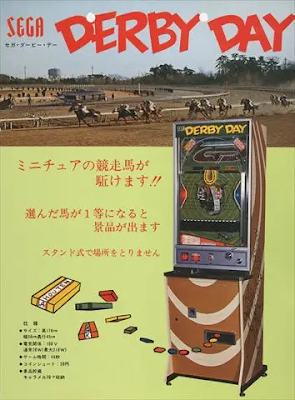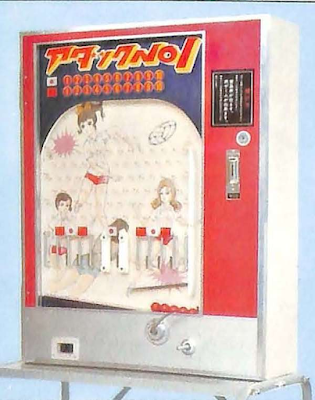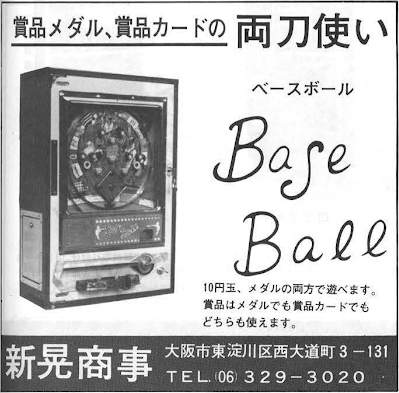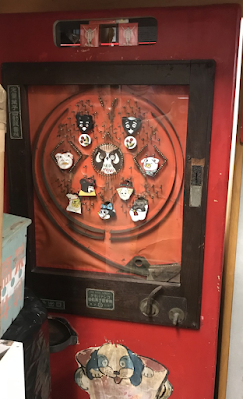I saw this machine on YJA and eventually it was reposted at a good enough price that I had to go for it. I am delighted that it arrived unscathed. I've used companies like Buyee and FromJapan to get machines from Japan to Canada and so far the shipping services have been amazing. (knock wood for good luck here)
In this post I want to look at what led us to arrangeball machines, and a bit more about this style of arrangeball in particular.
I am currently working on creating a list of all of the elecmeca arcade games made in Japan. That is a somewhat loose category which includes the mechanical & electromechanical, and basically just think of any kind of non-videogame arcade machine that you'd never be able to play on an emulator. Part of that push is cataloguing all of the token-based and prize-based pachi machines, which includes arrangeballs.
So here's an ask for everyone: If you have access to an arrange ball machine, I am super interested in your taxation tags to help determine the date it was manufactured. If your machine has any manufacturer information pointing to date or company, maybe on components inside, that is useful too. Please let me know!
Pre-ww2, around the late 1920s, the earliest pachinko-style machines wouldn't award anything. If you got it in a winning hole an operator would release it from the rear and most likely hand you a prize. Some of the earliest payout machines would pay out sen coins. Some pachinko-style games in the 1930s would pay out confectionary items. By far the most common, standard pachinko machines would pay out in more pachinko balls.
The Japanese arcade industry began it's rise in the late 50s with their first electromechanical hits, and the electromechanical era of the 60s and 70s saw numerous prize dispending pachi-style games. The most well know example, since it was exported internationally, was Sega's Derby Day from 1969 (or earlier):
 |
| ~1969 Derby Day - ダ ービーデー by セガ (Sega) a slightly modified version of this game was released in 1971 under the name Jockey Club |
There were many others, including Sankyo's Homerun! which also came from the late 60s. Note the prize hole near the bottom of each machine. Homerun used the far more standard pachinko design while Derby Day seemed to be trying something new with its playfield.
 |
| ~1969 Homerun! - ホームランゲーム by 三共 (Sankyo) |
You might be familiar with candystore games where the prize is a hunk of plastic with writing on it that you can redeem for candy. I am unsure when this convention started, but there is even a Derby Day flyer that implies it, although maybe those are boxes of candy?
 |
The first games I can find that shrink the prize hole down are from 1972, Maybe that is when they started using smaller plastic chunks for redemption? Maybe they are dispensing prize token coins? I am unsure.
 |
| 1972 日・ソ対抗バレーボール大会 (Japan-Soviet Volleyball Tournament) by 新精電機 (Shinsei Denki) the cabinet design obviously owes much to the German Super Match machine |
It is only in 1973 that I can find records of the first "classic" arrange ball machines, but I'm told they began in 1972. I just don't have access to a lot of materials from Japan from before 1973...
 |
| 1973 パイパイゲーム (Pai Pai Game) by 藤商事 & 大洋産業 (Fuji Shoji & Taiyo) |
 |
| 1973 Sammy Bingolet Arrange Ball - by さとみ (Satomi) |
There were earlier pachinko-cabinet games like this that dispensed tokens (mahjongg-style sparrow ball,) but the payout was done manually via an attendant validating the win and inserting a key. These new Arrange Ball games were electromechanical and could pay out wins automatically.
 |
| via the 1973 Fuji Shoji catalog: this game took in coins, and would only pay out when an attendant entered a key and turned it, after confirming your win. These machines have a long history. |
This was also the beginning of the Medal Game boom, so gambling with non-currency coins / tokens. Medal game parlors were all about "pretend gambling" though. You played for the experience, there was no cashing out. (as you can imagine there were some establishments that broke the law in this regard!) But arrangeballs, based on many old photographs I've seen, were installed in pachinko parlors where there was a defined relationship for trading out balls for an item/receipt and eventually for cash back (if desired). I will have to ask more questions about how arrangeball shops were run, but I am assuming the tokens were exchanged for cash.
The machine I picked up is a classic arrangeball: Coins that go in are also paid out. The same design, with a different playfield graphic, was released by Taito in 1976 in an upright cabinet that dispensed prizes, allowing them to sell the game to arcades for kids.
 |
| 1976 Base Ball by タイトー (Taito) |
The same parts were used by many companies and distributors. Until the late 70s, it was very common for games to have different manufacturers and sellers. Parts from different manufacturers were bought, and sometimes those companies were advertised alongside the company selling it, often times without much explanation, making it difficult to saw who "made" which game.
Here is another game that uses many of the same pieces, but has different pachinko cabinet parts, and different graphics.
 |
| 1976 Base Ball - ベースボール by 新晃商事 (Shinko Shoji) |
It appears that maybe you could purchase the center baseball diamond components, with the 4 lights and the LED numeric display? Here it is in a gambling game that does not even have any pachinko elements:
 |
| 1976 栄光の魔球 (Glory magic ball) by ウコー (Uko) |
Another game:
Before this very popular base-running electronic display took over in 1976 there was a simpler version in 1975 that did not have the LED number display:
 |
| 1975 Baseball by Kyoraku |
and this design framework was also applied to other themes, like boxing:
Here's a game with the same playfield as mine, but with different external chasis components. Who "made" this game? Really hard to say, there was a lot of collaboration via parts amongst manufacturers.







No comments:
Post a Comment